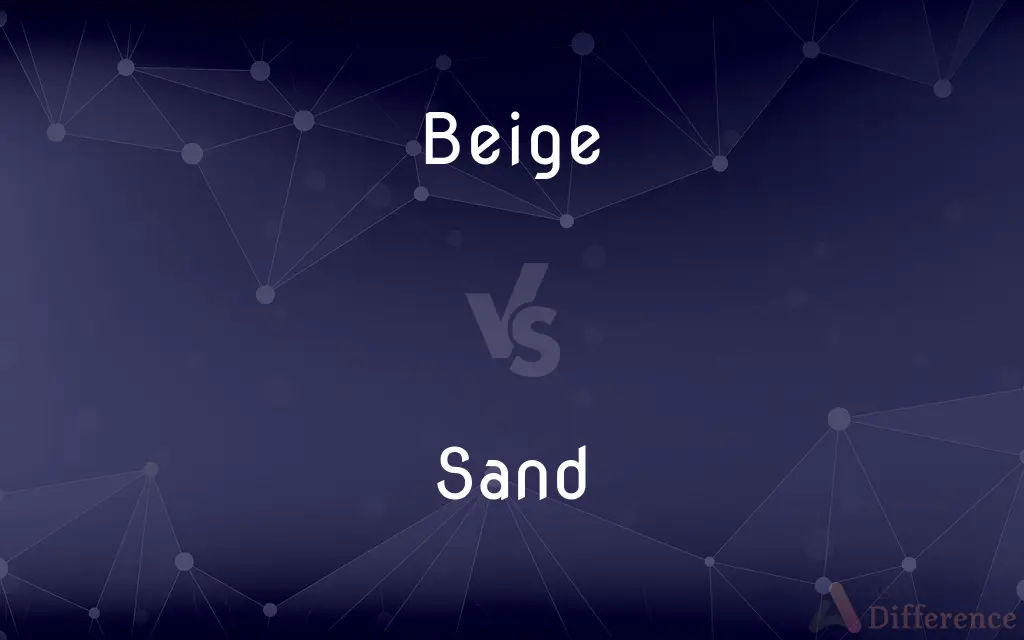Beige vs. Sand — What's the Difference?
By Fiza Rafique & Maham Liaqat — Updated on April 5, 2024
Beige is a pale, light brown color, often used in fashion and interiors for its neutral tone, while sand typically refers to a range of colors inspired by beach sand, often warmer and darker.

Difference Between Beige and Sand
Table of Contents
ADVERTISEMENT
Key Differences
Beige is a neutral, pale, light brown color, seen as versatile in fashion and home decor, offering a backdrop that pairs well with almost any color. Sand, on the other hand, can vary more in color, often reflecting the specific hues found in natural beach sand, ranging from pale yellows to rich browns.
The term "beige" is used in a variety of contexts to denote a color that is unobtrusive and subtly elegant, making it a favorite choice for items intended to blend with diverse palettes. Whereas "sand" evokes a natural, earthy feel, and is often used to describe colors with a bit more warmth and depth, suggesting a connection to the natural world.
Beige is often associated with simplicity, minimalism, and timelessness in design and fashion. It is chosen for its ability to remain understated yet sophisticated. Sand, while also versatile, tends to lean towards casual and relaxed themes, mirroring the laid-back vibe of beach settings.
In interior design, beige is a go-to color for creating serene and calm environments, used in spaces aiming for a refined and classic look. Sand colors bring a more organic and grounded feel to interiors, often used to create a cozy, warm, and inviting atmosphere.
While both colors are celebrated for their versatility, beige is typically considered more of a "true neutral," providing a foundation that allows other colors to stand out. Sand colors, embodying a range of tones, offer a slightly more dynamic palette, enabling designers to play with natural themes and textures.
ADVERTISEMENT
Comparison Chart
Hue
Pale, light brown.
Varies from pale yellows to rich browns.
Contexts of Use
Fashion, interiors, neutral backgrounds.
Nature-inspired themes, relaxed settings.
Associated Feel
Elegance, minimalism, versatility.
Warmth, earthiness, natural.
Design Approach
Understated sophistication, timelessness.
Organic, grounded, inviting.
Versatility
Seen as a true neutral, pairs with any color.
Offers a dynamic range, inspired by nature.
Compare with Definitions
Beige
Neutral and versatile color.
The beige walls provided a perfect backdrop for her vibrant art collection.
Sand
Inspired by natural beach sand.
The sand-colored curtains brought a piece of the beach into the living room.
Beige
Timeless in fashion and decor.
Beige trench coats remain a timeless piece in any wardrobe.
Sand
Varies in hues, reflecting nature.
The palette of sand colors used in the painting captured the beach at sunset perfectly.
Beige
Common in minimalistic designs.
The minimalist home utilized beige tones for a clean, serene look.
Sand
Dynamic and natural in design.
Incorporating sand tones, the designer added a natural, dynamic feel to the space.
Beige
Pairs well with almost any color.
The beige sofa effortlessly matched with both bright and dark accents.
Sand
Evokes warmth and earthiness.
The sand tones in the rug warmed up the entire room.
Beige
Elegant and understated.
Her beige dress was a masterpiece of subtle sophistication.
Sand
Favored for relaxed and casual themes.
The beach house's sand-colored exterior blended perfectly with its seaside setting.
Beige
Beige is variously described as a pale sandy fawn color, a grayish tan, a light-grayish yellowish brown, or a pale to grayish yellow. It takes its name from French, where the word originally meant natural wool that has been neither bleached nor dyed, hence also the color of natural wool.
Sand
Sand is a granular material composed of finely divided rock and mineral particles. Sand has various compositions but is defined by its grain size.
Beige
A pale sandy fawn colour
A beige raincoat
Tones of beige and green
Sand
Small loose grains of worn or disintegrated rock.
Beige
A light grayish brown or yellowish brown to grayish yellow.
Sand
(Geology) A sedimentary material, finer than a granule and coarser than silt, with grains between 0.06 and 2.0 millimeters in diameter.
Beige
A soft fabric of undyed, unbleached wool.
Sand
Often sands A tract of land covered with sand, as a beach or desert.
Beige
Light grayish-brown or yellowish-brown to grayish-yellow.
Sand
The loose, granular, gritty particles in an hourglass.
Beige
A slightly yellowish gray colour, as that of unbleached wool.
Sand
Sands Moments of allotted time or duration
"The sands are numb'red that makes up my life" (Shakespeare).
Beige
Debeige; a kind of woollen or mixed dress goods.
Sand
(Slang) Courage; stamina; perseverance
"She had more sand in her than any girl I ever see.
In my opinion she was just full of sand" (Mark Twain).
Beige
Having a slightly yellowish gray colour, as that of unbleached wool.
Sand
A light grayish brown to yellowish gray.
Beige
Comfortably dull and unadventurous, in a way that suggests middle-class suburbia.
Sand
To sprinkle or cover with or as if with sand.
Beige
Debeige.
Sand
To polish or scrape with sand or sandpaper.
Beige
A very light brown
Sand
To mix with sand.
Beige
Of a light grayish-brown color
Sand
To fill up (a harbor) with sand.
Sand
(uncountable) Rock that is ground more finely than gravel, but is not as fine as silt (more formally, see grain sizes chart), forming beaches and deserts and also used in construction.
Sand
A beach or other expanse of sand.
The Canadian tar sands are a promising source of oil.
Sand
Personal courage.
Sand
A particle from 62.5 microns to 2 mm in diameter, following the Wentworth scale.
Sand
A light beige colour, like that of typical sand.
Sand
A single grain of sand.
Sand
A moment or interval of time; the term or extent of one's life (referring to the sand in an hourglass).
Sand
(colloquial) A sandpiper.
Sand
Of a light beige colour, like that of typical sand.
Sand
(transitive) To abrade the surface of (something) with sand or sandpaper in order to smooth or clean it.
Sand
(transitive) To cover with sand.
Sand
To blot ink using sand.
Sand
Fine particles of stone, esp. of siliceous stone, but not reduced to dust; comminuted stone in the form of loose grains, which are not coherent when wet.
That finer matter, called sand, is no other than very small pebbles.
Sand
A single particle of such stone.
Sand
The sand in the hourglass; hence, a moment or interval of time; the term or extent of one's life.
The sands are numbered that make up my life.
Sand
Tracts of land consisting of sand, like the deserts of Arabia and Africa; also, extensive tracts of sand exposed by the ebb of the tide.
Sand
Courage; pluck; grit.
Sand
To sprinkle or cover with sand.
Sand
To drive upon the sand.
Sand
To bury (oysters) beneath drifting sand or mud.
Sand
To mix with sand for purposes of fraud; as, to sand sugar.
Sand
A loose material consisting of grains of rock or coral
Sand
French writer known for works concerning women's rights and independence (1804-1876)
Sand
Fortitude and determination;
He didn't have the guts to try it
Sand
Rub with sandpaper;
Sandpaper the wooden surface
Common Curiosities
How does sand color differ from beige?
Sand color encompasses a range of hues from pale yellows to rich browns, inspired by natural beach sand, and often appears warmer and more varied than beige.
Can sand colors be considered neutral?
Yes, sand colors can be considered neutral, especially in designs and themes inspired by nature, offering a warm and organic feel.
What is the color beige?
Beige is a pale, light brown color, known for its neutrality and versatility in fashion and interiors.
Are there any fashion tips for wearing beige or sand colors?
Both colors pair well with a wide range of tones, but beige offers understated elegance, while sand colors bring a more relaxed, natural vibe to outfits.
Is beige a warm or cool color?
Beige is generally considered a warm, neutral color, but its tone can vary slightly depending on specific undertones.
Why is beige so popular in design?
Beige is popular for its versatility, simplicity, and the elegant backdrop it provides, allowing other design elements to stand out.
What settings are sand colors best suited for?
Sand colors are well-suited for settings that aim to evoke warmth, earthiness, and a connection to the natural world, such as beach houses or rooms with an organic theme.
How do beige and sand colors affect room ambiance?
Beige colors create serene, calm environments with a sophisticated touch, while sand colors offer a cozy, warm, and inviting atmosphere.
What are the psychological effects of beige and sand colors?
Beige can evoke feelings of calmness, reliability, and flexibility, while sand colors can create a sense of warmth, comfort, and grounding.
Can beige and sand colors be used together?
Yes, beige and sand colors can be used together to create a layered, nuanced palette that’s both neutral and warm, enhancing the sense of harmony in a space.
Share Your Discovery

Previous Comparison
Multinomial vs. Polynomial
Next Comparison
Writ vs. SummonsAuthor Spotlight
Written by
Fiza RafiqueFiza Rafique is a skilled content writer at AskDifference.com, where she meticulously refines and enhances written pieces. Drawing from her vast editorial expertise, Fiza ensures clarity, accuracy, and precision in every article. Passionate about language, she continually seeks to elevate the quality of content for readers worldwide.
Co-written by
Maham Liaqat













































